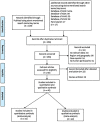A Systemic Literature Review and Meta-Analysis Reporting the Prevalence and Impact of Methicillin-Resistant Staphylococcus aureus Infection in India
- PMID: 33223835
- PMCID: PMC7656882
- DOI: 10.1177/1178633720970569
A Systemic Literature Review and Meta-Analysis Reporting the Prevalence and Impact of Methicillin-Resistant Staphylococcus aureus Infection in India
Abstract
Aim and objective: This systematic review and meta-analysis was conducted to assess the prevalence, burden and epidemiology of methicillin-resistant S. aureus (MRSA). This systemic review was also aimed to highlight the challenges in the diagnosis and management of methicillin-resistant S. aureus (MRSA) in India (for all age groups). We also examined the published literature on the available treatment options and the role of prevention in the management of MRSA in India. By summarizing the currently available data, our objectives were to highlight the need for the prevention of MRSA infections and also emphasize the role of vaccination in the prevention of MRSA infections in India.
Methodology: Electronic databases such as PubMed and databases of the National Institute of Science Communication and Information Resources and Indian Council of Medical Research Embase were searched for relevant literature published from 2005/01/01 to 2020/05/13 in English language, according to the predefined inclusion and exclusion criteria. A manual search was also conducted using the key term "MRSA 'or' Methicillin Resistant Staphylococcus aureus 'and' India." An independent reviewer extracted data from the studies using a structured Microsoft Excel spreadsheet, and a meta-analysis of proportion for MRSA prevalence with a corresponding 95% confidence interval (CI) for all included individual studies were performed.
Result: A total of 34 studies involving 16 237 patients were included in the final meta-analysis. The pooled proportion of patients with MRSA infection was 26.8% (95% CI: 23.2%-30.7%). The MRSA infection was more prevalent among male patients (60.4%; 95% CI: 53.9%-66.5%) as compared to female patients (39.6%; 95% CI: 33.5%-46.1%), while the prevalence of MRSA was higher among adults (18 years and above; 32%; 95% CI: 5%-80%) in comparison to pediatric patients (0-18 years; 68%; 95% CI: 20%-94.8%). The degree of heterogeneity was found to be significant.
Conclusion: The prevalence of MRSA in India was relatively high at 27% with a higher proportion observed among men aged >18 years. The high prevalence of MRSA infections in India necessitates the implementation of surveillance and preventive measures to combat the spread of MRSA in both hospital and community settings.
Keywords: India; Methicillin resistant S. aureus; prevalence.
© The Author(s) 2020.
Conflict of interest statement
Declaration of conflicting interests:The author(s) declared no potential conflicts of interest with respect to the research, authorship, and/or publication of this article.
Figures


Similar articles
-
Prevalence of Methicillin-resistant Staphylococcus Aureus in India: A Systematic Review and Meta-analysis.Oman Med J. 2022 Jul 31;37(4):e440. doi: 10.5001/omj.2022.22. eCollection 2022 Jul. Oman Med J. 2022. PMID: 35949712 Free PMC article. Review.
-
Methicillin-resistant Staphylococcus aureus in Intensive Care Unit Setting of India: A Review of Clinical Burden, Patterns of Prevalence, Preventive Measures, and Future Strategies.Indian J Crit Care Med. 2020 Jan;24(1):55-62. doi: 10.5005/jp-journals-10071-23337. Indian J Crit Care Med. 2020. PMID: 32148350 Free PMC article. Review.
-
Correlation Between Biofilm Formation and Antibiotic Resistance in MRSA and MSSA Isolated from Clinical Samples in Iran: A Systematic Review and Meta-Analysis.Microb Drug Resist. 2020 Sep;26(9):1071-1080. doi: 10.1089/mdr.2020.0001. Epub 2020 Mar 10. Microb Drug Resist. 2020. PMID: 32159447
-
Prevalence of and risk factors for methicillin-resistant Staphylococcus aureus colonization in HIV infection: a meta-analysis.Clin Infect Dis. 2014 Nov 1;59(9):1302-11. doi: 10.1093/cid/ciu559. Epub 2014 Jul 16. Clin Infect Dis. 2014. PMID: 25031291 Free PMC article.
-
Nasal colonization of methicillin resistant Staphylococcus aureus in Ethiopia: a systematic review and meta-analysis.Ann Clin Microbiol Antimicrob. 2019 Sep 5;18(1):25. doi: 10.1186/s12941-019-0324-y. Ann Clin Microbiol Antimicrob. 2019. PMID: 31488199 Free PMC article.
Cited by
-
Molecular Confirmation of Vancomycin-Resistant Staphylococcus aureus with vanA Gene from a Hospital in Kathmandu.Int J Microbiol. 2021 Dec 2;2021:3847347. doi: 10.1155/2021/3847347. eCollection 2021. Int J Microbiol. 2021. PMID: 34899917 Free PMC article.
-
High Prevalence of Methicillin-Resistant Staphylococcus aureus among Healthcare Facilities and Its Related Factors in Myanmar (2018-2019).Trop Med Infect Dis. 2021 May 6;6(2):70. doi: 10.3390/tropicalmed6020070. Trop Med Infect Dis. 2021. PMID: 34066500 Free PMC article.
-
Preparation and optimization of niosome encapsulated meropenem for significant antibacterial and anti-biofilm activity against methicillin-resistant Staphylococcus aureus isolates.Heliyon. 2024 Aug 6;10(16):e35651. doi: 10.1016/j.heliyon.2024.e35651. eCollection 2024 Aug 30. Heliyon. 2024. PMID: 39211930 Free PMC article.
-
Molecular Epidemiology and Characterization of Multidrug-Resistant MRSA ST398 and ST239 in Himachal Pradesh, India.Infect Drug Resist. 2023 Apr 20;16:2339-2348. doi: 10.2147/IDR.S409037. eCollection 2023. Infect Drug Resist. 2023. PMID: 37125211 Free PMC article.
-
MRSA Profiles Reveal Age- and Gender-Specificity in a Tertiary Care Hospital: High Burden in ICU Elderly and Emerging Community Patterns in Youth.Microorganisms. 2025 May 6;13(5):1078. doi: 10.3390/microorganisms13051078. Microorganisms. 2025. PMID: 40431251 Free PMC article.
References
LinkOut - more resources
Full Text Sources

